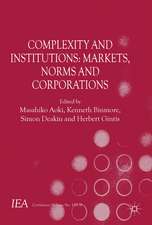Nicholas Kaldor and Mainstream Economics: Confrontation or Convergence?
Autor Edward J. Nell, Willi Semmleren Limba Engleză Paperback – 1991
Preț: 657.25 lei
Preț vechi: 773.23 lei
-15% Nou
Puncte Express: 986
Preț estimativ în valută:
125.82€ • 131.28$ • 105.47£
125.82€ • 131.28$ • 105.47£
Carte tipărită la comandă
Livrare economică 12-26 martie
Preluare comenzi: 021 569.72.76
Specificații
ISBN-13: 9781349109494
ISBN-10: 1349109495
Pagini: 620
Ilustrații: XV, 620 p.
Dimensiuni: 155 x 235 x 33 mm
Greutate: 0.89 kg
Ediția:1st ed. 1991
Editura: Palgrave Macmillan UK
Colecția Palgrave Macmillan
Locul publicării:London, United Kingdom
ISBN-10: 1349109495
Pagini: 620
Ilustrații: XV, 620 p.
Dimensiuni: 155 x 235 x 33 mm
Greutate: 0.89 kg
Ediția:1st ed. 1991
Editura: Palgrave Macmillan UK
Colecția Palgrave Macmillan
Locul publicării:London, United Kingdom
Cuprins
Part 1 Nicholas Kaldor - an overall evaluation: Nicholas Kalder 1908-1986, A.P.Thirwall; Nicholas Kaldor remembered, J.K.Galbraith. Part 2 Methodology and basic approach: Kaldor between Hayek and Keynes, or - did Nicky kill capital theory? M.Desai; a sweeping new non-substitution theorem - Kaldor's discovery of the Von Neumann input-output model, P.A.Samuelson; equilibrium and stability in classical theory, D.J.Harris; on the resolution of conflicts by compensation, U.Krause; the impact of the division of labour on market relations, T.Scitovsky. Part 3 Saving and distribution: profit squeeze and Keynesian theory, S.A.Marglin and A.Bhaduri; post-Keynesian theory of distribution in the long run, N.Salvadori; corporate behaviour, valuation ratio and macro-economic analysis, G.Abraham-Frois. Part 4 Money and macroeconomics: the endogeneity of money, H.P.Minsky; on the endogeneity of money supply, J.Tobin; Marx, Keynes, Kalecki and Kaldor on the rate of interest as a monetary phenomenon, B.J.Moore; money - cause or effect? exogenous or endogenous?, P.Davidson; change, continuity and originality in Kaldor's monetary theory, M.Lavoie. Part 5 Business cycles: a Keynesian business cycle, R.Day; perfect foresight cycles in a Marxian-Keynesian model of accumulation with money, D.K.Foley; wandering around the warranted path - dynamic nonlinear solutions to the harrodian knife-edge, A.Shaikh; a dynamical macroeconomic growth model wth external financing of firms - a numerical stability analysis, R.Franke and W.Semmler; a working model of slump and recovery from disturbances to capital-goods demand in a closed non-monetary economy, E.S.Phelps; cyclical growth in a Kaldorian model, P.Skott; endogenous credit and endogenous business cycles, M.Jarsulic. Part 6 Theory of growth: change and continuity in Kaldor's thought on growth and distribution, F.Targetti; technical change, growth and distribution - a steady state approach to "unsteady" growth on Kaldorian lines, H.D.Kurz; a Kaldorian saving function in a two-sectoral linear growth model, H.Hagemann; international debts and deficits - a Kaldor/Pasinetti model, H.Gram. Part 7 Empirical evidence on post-war growth: Kaldor's growth theories - past, present and prospects for the future, R.Boyer and P.Petit; Kaldor's macro system - too much cumulation, to few contradictions, D.M.Gordon; disembodied technical progress - theory and measurement, S.Nagy. Part 8 Economic policy and economic systems: Nicholas Kaldor as advocate of commodity reserve currency, A.G.Hart; Kaldor on international economic policy, S.Dell; demand scarcity and supply shortage in capitalism and socialism, E.Nell.














